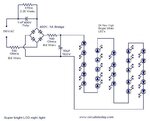haroon_tech
Member level 2
hi,
i am designing a super led night lamp using high power leds. ...
i have attached that ckt ...
in that ckt i need to build a fullwave rectifier,so made it using doides IN4007 input voltage is 230v AC ,i am not using any Transformer at the input, getting ouput voltage of 300v DC .........
my problem is i dont know at what voltage this leds glow,
.is rectifier ouput voltage(300 )correct output voltage giving ? if it is correct how can i reduce that voltage?..........
attached ckt....
can any body help me out............
i am designing a super led night lamp using high power leds. ...
i have attached that ckt ...
in that ckt i need to build a fullwave rectifier,so made it using doides IN4007 input voltage is 230v AC ,i am not using any Transformer at the input, getting ouput voltage of 300v DC .........
my problem is i dont know at what voltage this leds glow,
.is rectifier ouput voltage(300 )correct output voltage giving ? if it is correct how can i reduce that voltage?..........
attached ckt....

can any body help me out............
Last edited: